|
These are the bare facts: the Mogao cave complex is comprised of 492 caves, containing 450,000 square feet of murals dating from the fourth to the fourteenth centuries – a period which corresponds to an immense growth in international commerce along the nearby Silk Road. The caves were abandoned in the fourteenth century and lay untouched until the beginning of the twentieth century. These facts presume ten centuries of consecutive public works programs of astonishing financial proportions and startling logistical complications. They anticipate unparalleled craftsmanship especially during the Tang (608-907) and Yuan (1227-1368) dynasties when China was a global superpower. History Buddhist cave art originated in the second century B.C.E. in Maharashtra, India – an area of commercial importance for trade flows between north and south India. Between the inception at the older site at Ajanta and the completion of further ones at a nearby site at Ellora in the eighth century, some 63 caves were excavated and painted. The Mogao Caves, begun six centuries later in the fourth century, were positioned on the more prosperous international trading network, known as the Silk Road. With 492 painted grottoes, the Mogao Caves have more than eight times as many grottoes as those at India's primary two sites. That said, the Mogao Caves should not be understood as an isolated endeavor within China. They are merely the best example of an astonishingly widespread Buddhist cave movement in this nation. Apart from the UNESCO-registered grottoes at Dazu, Longmen & Yungang, prominent Buddhist grottoes on the Silk Road are the Kizil Caves near Kuqa, on which much of the content if not style of the earliest Mogao Caves are based, and the Bezeklik Caves near Turpan in China's western Xinjiang province. Within their home province of Gansu, the Mogao Caves are but one of several painted cave complexes with nearby grottoes at Yulin, the Western Thousand Buddha Caves and Eastern Thousand Buddha Caves, as well as further afield, notably at Maijishan, Binglingsi and Laoshansi. Indian in origin, Buddhist cave art was soon wholeheartedly promoted in many cultural centers throughout China both on the Silk Road network and off. Functions Buddhist cave art, like Buddhism, was an Indian export to China. Over time, its original ideological function was embellished with features required by Buddhism's synthesis into China's political and religious life.
The Indian tradition of sannyasa refers to the concept of renouncing attachments to the material world in order to devote oneself entirely to spiritual matters. This concept developed in two ways: The first, outlined in the "Bhagavad Gita", is the principle of internalizing this concept so that it inspires one's daily life. The second is the physical execution of this ideal by formally renouncing the various comforts of society for the austerity of a remote location where the spiritual aspirant devotes him/herself to the search for enlightenment. A remote cave offers peace and shelter as well as an environment suited to spiritual endeavor. Neither light nor dark, high nor low, enclosed nor exposed, a cave is a metaphor for a dimension that exists beyond the worlds of reality and unreality. The cave thereby became a place for spiritual search. It was but a small elaboration to painting the caves' walls with emblems to facilitate meditation or with visualizations derived from the search for enlightenment. Sannyasa originally relates to an individual's search for enlightenment. However, even before the institution of the Mahayana school of Buddhism, there was evidence of devotees' zeal to enlighten their contemporaries. Caves also became loci of pedagogy and the tools of proselytizers. Cave paintings came to have the function of publicizing Buddhist stories and concepts to an illiterate audience. The images became attractive and accessible libraries of Buddhist sutras (teachings) and jataka (moral tales of previous incarnations of the Buddha). (ii) Subsequent Political Functions Assuring Imperial Legitimacy To understand the political value of Buddhism to China's rulers, it is useful firstly to introduce an axiom of Mahayana Buddhism, which was the strain of Buddhism that became popular in China. Mahayana Buddhism innovated the concept of the bodhisattva (enlightenment being). This is an individual who has attained supreme enlightenment but delays his or her entry into nirvana (the state of enlightenment ) in order to make possible the salvation of fellow sentient beings. The bodhisattva is a figure of immense authority, which represents and acts out of enlightenment, compassion and self-sacrifice on behalf of all other beings. As such, it is a potent potential political metaphor for a ruler. The heyday for Buddhism, as well as for murals at the Mogao Caves, was during the first half of the Tang dynasty (618-781). This period featured three highly successful Emperors: Emperor Taizong (626-649), Emperor Wu (684-704 – China's only female Emperor) and Emperor Xuanzong I (712-755). Apart from the successes of their reigns, these Emperors shared only one other common experience – that of ascending to the throne in violation of the sacrosanct conventions of succession. Their accessions to the throne were tainted with illegalities. Their subsequent patronage of Buddhism bore the political goal of using for themselves the bodhisattva image to wipe clean the disrepute of their usurpation. The clearest challenge to the existing order came from Emperor Wu (a woman). Hence, the 100 foot White Buddha in cave 96 was sculpted in her lifetime and was modeled on her physiognomy. Similarly, the 75 foot Black Buddha of nearby cave 130 was constructed during the reign of Emperor Xuanzong I. The legitimacy of the Imperial regime through association with a populist Buddhist order was maintained explicitly and implicitly. Firstly, the Emperors sponsored Buddhist public works programs. Secondly, as stated above, the likeness of Emperors and of other members of the ruling elite were incorporated within the Buddhist cosmogony. Thirdly, the appearances of popular Buddhist scenes were adapted to resonate to the culture of the Imperial Palace. For example, the architecture of Amitabha's Western Palace closely resembled that of the Emperor's Imperial one. Otherwise, in the traditional figures of the flying apsara (Hindu mythological nymphs), musicians, Buddhas and Bodhisattvas could be seen references to the maids, singers, dancers and musicians of the Imperial palace. Although a foreign import, Buddhism suffered no discrimination in China. It was integrated within a holistic, world religious view. Instead of interpreting it as a threat to the status quo, Buddhism was at first co-opted by the ruling Imperial elite to garner popular support. Fostering Cohesion In A Multi-ethnic Nation The Tang dynasty was a time of increasing affluence and surging military expansion. Commerce fostered upward mobility w The Mogao Caves are notable for their holistic integration of the disparate groups and individuals displayed on their walls. Deities, Imperial likenesses and wealthy donors are provided pride of place but commoners and ethnic minorities are also included within a mosaic of socially and culturally harmonious bliss. The culturally syncretizing and socially unifying function of the paintings appears even to transgress the boundaries of the caves' original inspiration, Buddhism. Part of the uniqueness of these grottoes is in their holistic integration of indigenous Chinese philosophies, such as Daoism and Confucianism. This is historically accurate in that Confucianist and Daoist concepts did encourage the evolution of Mahayana Buddhism into Chan (or Zen) Buddhism in China in the fifth century. However, dressing an imported ideology in the garb of traditional Chinese philosophies and heroic tales is also politically expedient both for the ruling elite and to further engender the propagation of Buddhism in China. Diplomacy As the fame of Mogao Caves became widespread, cave dedications were used to cement political relationships. The collapse of the Tang dynasty created a power vacuum filled by contending regimes. By 907 it was the Cao family who controlled the Dunhuang region. In order to guarantee the integrity of their kingdom vis-a-vis the powerful Khitan and Nurchen kingdoms to the east, they forged alliances with powerful western kingdoms. As part of an alliance with the King of Khotan, the ruler Cao Yijin dedicated murals in this king's honor. (iii) Social Function Social Prestige Daoism and Confucianism induced two important mutations to Buddhism as it developed in China. Confucianism emphasizing the inherent goodness of humans taught that "everyone can become a sage." Daoism meanwhile underlined that the process of enlightenment was not gradual over many lifetimes but sudden and hence achievable within one lifetime. These innovations of the predominant Chinese or Chan (Zen in Japan) sect of Buddhism brought the promise of paradise closer to adherents and, as a result, accelerated the propagation of the Chan Buddhist sect. It became possible for a wealthy individual to allude to his or her own duanwu (sudden enlightenment) by sponsoring the excavation and decoration of a cave. A large contribution to the Buddhist cosmogony at the Mogao Caves by association guaranteed the prominence of the donor's social standing. Although some commentaries claim that often it was wealthy traders who financed the caves as a form of heavenly guarantee to ward off the risks of their perilous Silk Road journey, there is little evidence to support this. In fact, as attested by dedications painted on the cave murals, most of the Mogao Caves' donors were members of the local political elite. Clan Hall As donors featured themselves more prominently amongst the murals, the cave shrines took on an additional role, that of clan hall. Cave 220, for example, popularly known as the "Zhai Family Cave", features ten generations of the prominent, local Zhai family. As such, this cave is a metaphor for the process of cultural synthesis by which the originally Buddhist role of the caves was integrated into the pre-existing, indigenous values, customs and beliefs of China. The Founding According to "An Account Of Buddhist Shrines" written by Li Junxiu during the reign of Tang Empress Wu (684-704), a monk named Lezun (also known as Yuezun) founded the Mogao Caves in 366. It is said this monk's favorite disciple, Zhiqin, had a holy vision here. As the last rays of the sun struck the peak of Sanwei Mountain, the disciple Zhiqin looked up to see the Maitreya Buddha (Buddha of the future) sitting in a golden light, surrounded by a host of celestial maidens playing musical instruments and dancing for his entertainment. So awe-struck was the disciple that he immediately took up hammer and chisel, hollowed out the first of the grottoes and painted his vision there. Scientists refer to large mica deposits in Sanwei Mountain as a possible explanation for the intense golden light related within Zhiqin's vision. Also several accounts refer to the great thirst and fatigue of the monk prior to his vision and thereby seem to imply the potential for a hallucination. The Development Of The Caves The complexities of excavating a cave, of importing high quality materials for its facing and decoration, as well as of fostering local artistic talents and Buddhist learning demanded not only heavy financing, but also a high degree of coordination. At this well-guarded outpost of the Hexi corridor, it is unsurprising that the Art Academies and management mechanisms created for the caves' development were incorporated within the already existent military structure. Among the inscriptions for the donors in both the Mogao and Yulin grottoes are: "Painted by the artisans of the first department of the Military Command"; "Painters under the Military Command"; "Calligraphers of First and Second departments of the Military Command"; "Officer in-charge of engraving" and "Officer in charge of cave-cutting". Whilst such formalities suggest a disciplined & stark working environment, provision vouchers for wines and viands from the records of the Cao family, which sponsored 11 caves during the tenth century, indicate a jollier atmosphere. The wine bills reveal the hierarchy of workers at the caves. Whilst painters and masons were supplied with "fine" quality, other workers were issued with "inferior" supplies. The relationship between resident artists and donors can be seen from one of the Dunhuang Manuscripts, which gives an account of master artist Colonel Dong Baode. He "had noble aspirations and a gentle temperament, an example of an honest gentleman of compassion and proper conduct. Objects came to life in his sketches, and his paintings of Buddha surpassed his predecessors'. Conversant with Buddhist scriptures and accomplished in Confucian norms and propriety, he was recommended to the King of the Cao family… Dong Baode served the noble cause while being generously rewarded. His family became affluent with provisions to spare. He consulted his colleagues (seniors and juniors) about repaying his indebtedness to the royal family while redeeming his devotion to the Enlightened One. They all agreed to dedicate themselves to the construction of the holy shrines." There are many variations in the architecture, statuary and murals of the 492 caves built over a thousand-year period. Here will be offered an introduction to the basic themes present in a majority of caves. Basic Design The most basic cave design is that of a rectangular room. Meditation caves, called chanku, have two small meditation rooms either side of a main hall. A later development was the incorporation of a four-sided column in the center of the main hall, whose purpose was to create a circumambulatory path for worshippers around the cave. Overhead, until midway through the sixth century, the cave roof's cross-sectional shape was usually that of the top of an inverted U, also known as an "inverted dipper" ceiling. Later, a tiered canopy structure, modeled on an Imperial umbrella, was developed. While the most basic cave has one altar in its western wall, one with a central column might have one to four altars installed in the wide faces of this central column. Inside the altars, and also in wall niches, are placed painted stucco statues. Colorful murals cover every inch of the surrounding cave walls, the notion of plenitude being fundamental to many of the various painted themes. The floors are often covered with kiln-fired, lotus-patterned tiles. The ceiling usually bears a chessboard or caisson pattern (See "Decorative Designs" in a later section). Of the four walls, the most important is the western wall, opposite the easterly entrance for prominent viewing. The cave's main theme is painted in its center. Common arrangements for this central image include single-theme paintings, group paintings, a comic-strip sequence of small tableau, gigantic sutra illustrations and screen paintings (where the wall is divided into usually six painted parts in the style of a screen.) Depending on decorative fashions and on whether the image's purpose was to portray an individual, landscape, deity or story, various formats could be chosen for allocating wall space around the main image. Statuary Murals form the main component of Dunhuang's art. This is a suitable juncture to introduce the common layout and subjects of the painted stucco statues. The first caves featured the Buddha (enlightened one), either as Maitreya (Buddha of the future) or as Sakyamuni (the historical Buddha, Prince Siddartha Gautama) with attendant Bodhisattvas either side. More often than not the Buddha is shown in a meditative posture – a reference to the original purpose of cave shrines. In the Northern Wei dynasty (439-534), two disciples were added to this arrangement: Ananda (Sakyamuni's youthful cousin, known for his intelligence) and Kasyapa (a stern disciple famous for his strict devotion). This enlarged the group to five. From the Tang dynasty (618-907), seven to ten statues were customarily grouped around the Buddha in hierarchical order. Outside the disciples and Bodhisattvas would appear Lokapalas (guardian warriors), Vajra warriors (protectors of the Buddhist law) and kneeling attendants. These would be reinforced by paintings on the back wall behind the statues. For example, behind statues of the two disciples Ananda and Kasyapa might be painted eight eminent monks bringing the total number to the ten chief disciples of Buddha. The three most famous stucco statues at the Mogao Caves are the early Tang dynasty (618-781) Northern and Southern Buddhas, 33 meters (approx. 100 feet) and 26 meters (approx. 80 feet) tall, and the massive 16 meter wide (50 foot) Sleeping Buddha. Since the Northern Buddha has been the subject of many renovations, the first dating to the tenth century, the Southern Buddha is usually accorded greater attention. Mural Motifs
Derived from Hindu mythology, an apsara is a celestial courtesan. In India, they were originally portrayed as nude, haloed female musicians, riding in clouds and showering flower petals. When this mythological character traveled from India to the more conservative cultural climate of Confucianist China, its bold presentation was toned down. The apsara of the Mogao caves do not travel on clouds, nor are they painted with a halo. Similarly, the potent sexuality of the Indian figure has been muted; only the upper torso of the Dunhuang apsara is naked, and this is partly obscured by the innovation of a long Persian scarf that floats around the flying angel. Often these mythological beings are used to decorate wide borders along the upper parts of walls, commonly at divisions between the top of the wall and the ceiling or within the ceiling design itself. For the pictoral development of apsara, please consult the Apsara Photogallery. Musicians
Thousand Buddhas One of the alternative names for the Mogao Caves is the "Thousand Buddha Caves". This number should not be taken literally. Firstly, it refers to the density of the caves' innumerable Buddha images and statues. Secondly, thousand buddhas or qianfo is also used to refer to the miniature Buddha figures painted in a pattern on many walls. A stereotype is grouped with four or five differently colored copies and this grouping is repeated across the wall to create a myriad concentration of Buddha images. The intensity of this repetition is designed to fuel the religious mysticism surrounding the "realm of the Buddha". Vajra Warriors These are the ferocious-looking guardians of dharma (Buddhist law) that customarily appear on the lower parts of many cave walls. They are powerfully built, often painted with upraised arms or performing martial exercises. During the Tang dynasty in particular their physique and musculature were exaggerated for aesthetic effect. Donors Donors are customarily identified with text labels by their images. Indian cave shrines do not contain pictures of donors. In the earliest Chinese caves of the fourth century, donors are featured. They are presented as a class of individual rather than as individuals themselves. There is minimal characterization distinguishing between hundreds of named portraits featured as addendum on the lower parts of the walls. Donors were proud merely to be included in the murals as venerators of Buddhism. By the Tang dynasty (618-907), the portrayal of donors had changed significantly. They are shown in larger than life portraits on either side of the corridor leading to the cave, as well as on the eastern wall directly opposite the main western one, even pictured greeting the Buddhist deities facing them. Indeed, cave 98 has 169 portraits of the distinguished, local Cao family and cave 220, known as the "Zhai Family Cave", has ten generations of the Zhai family. What had begun as the extension of a pre-established Confucianist ethic of ancestor worship had evolved to fulfill the role of clan hall. The Mogao Caves prime role as Buddhist shrine had been supplemented with a secondary one as a clan hall. It was not just in size and number that the presentation of donors differed. Whereas the depiction of the deities was bound by age-old conventions, the painting of laity evolved according to the dictates of fashion. For example, the dress of the deities remains invariably Indian throughout the caves whereas that of the donors varies. Similarly, the Tang dynasty penchant for expansive waistlines is reflected in the well-nourished triple chins of the donors of this period. The inviolability of convention in painting deities carries through to coloring techniques. The original Indian-inspired three-dimensional perspective technique is employed throughout the centuries for the depiction of deities whereas new coloring refinements are constantly introduced for images of the laity (See Painting Technique). Decorative Designs Towards the early Tang period (618-781), an important innovation in cave design occurred; this was the shift in ceiling design from that of the top of an inverted U (also known as an "inverted dipper") towards a canopy design, modeled on the Emperor's umbrella. This innovation in its wake resulted in further evolutions in cave design. The first was the introduction of the caisson into the square of the canopy ceiling. The caisson is a painted square, customarily decorated with a circular design featuring a lotus. It can be further enhanced with an interlinked rabbit ear decoration as well as traditional Chinese ceiling emblems. The second evolution of this period was a shift in decorative focus away from the apsara (celestial courtesans) and deities (thousand Buddhas) towards greater accentuation of geometric and floral shapes. This is not to suggest that apsara and thousand Buddhas were no longer included in the decorative design, but to indicate merely that they became the most important of many new patterns. The rich multiplicity of new patterns resulted in a wide range of design from floral patterns (lotuses, pomegranates and curry leaves amongst many others), to geometric patterns (inspired by interlocked branches and dancing dragons, amongst others) to textile patterns. A further area of decorative evolution is in the costumes. Archeological evidence from Tang dynasty burial sites, particularly at nearby Turpan, have uncovered examples of the beautifully woven, complicated brocade designs that are featured in the murals and stucco statues of the Mogao Caves. This evolution of costume can be clearly seen in the painted dress of donors. Auspicious Symbols The aim for this section is not to familiarize readers with the meanings and history of auspicious symbols, but rather to touch upon a fascinating phenomenon, which helps explain part of the enormous significance of the Mogao Caves to Central Asian art history. Starting in the latter half of the Tang dynasty (781-907), following the enormous boom in traffic along the Silk Road, auspicious symbols from Central Asia and Northern India were replicated on the walls of the Mogao Caves. As a result of war and destruction in their homeland, in some cases, the Mogao Cave image is the only surviving extant example of the imported auspicious symbol.
|
By Guy Rubin
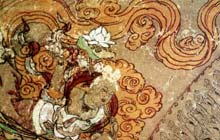 Centuries ago, in a cliff-face in the midst of China's vast Taklamakan desert, artists hollowed, sculpted and painted 492 caves, creating over 450,000 square feet of spectacular murals, or more than thirty times the mural area of the Sistine Chapel. But whereas the Sistine Chapel was painted over a few years, the works at the Mogao Caves began in the fourth century and were completed over the next millennium.
Centuries ago, in a cliff-face in the midst of China's vast Taklamakan desert, artists hollowed, sculpted and painted 492 caves, creating over 450,000 square feet of spectacular murals, or more than thirty times the mural area of the Sistine Chapel. But whereas the Sistine Chapel was painted over a few years, the works at the Mogao Caves began in the fourth century and were completed over the next millennium.
Given that over that thousand year period competing Imperial dynasties, local aristocracies and even foreign nations conquered the nearby city of Dunhuang, it would have been an astounding feat, perhaps even a miracle, for the painted caves to have survived the subsequent wars and mayhem. However, the Mogao caves – in spite of the unavoidable cultural differences between these different religions and peoples – did not just survive, they prospered through this period. For although rival dynasties, families, tribes, religions and nationalities dominated the area, the sheer magnificence of the Mogao Caves was so overwhelming as to prevail over any differences in its successive rulers. Rather than destroy all vestige of their predecessors, a new ruler would instead fund local artists to incorporate his image into the mythological chorus of the caves' hallowed murals. The ruler would thereby use the caves' beauty to legitimize his new administration. In this way, art served as a bridge linking different peoples to each other; the murals provided a space in which alien cultures could make compromises to each other and salve potential sources of enmity. They were used to finesse contradictions between rich and poor, between Confucianists and Buddhists and between Tibetans, Han and other ethnicities. As such, the murals of the Mogao Caves, bespeaking a universal harmony, herald the triumph of transcendent beauty over the destructive dynamic of temporal orders.
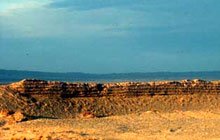 Compare this example of cultural intercourse and compromise with another of Dunhuang's famous sites – the remnants of the earliest sections of the Great Wall. This 16 foot high wall of stamped earth, reinforced with wood, appears as spectacularly random in the midst of the world's second-largest desert. Over two thousand years old, this sinuous fortification, as weathered and cracked as the gargantuan rock formations it purports to divide, now seems more a product of nature than of humanity. Even though the power and scale of the seemingly infinite desert mock the Great Wall's pretensions to mastery, it is an achievement for this human endeavor to have been constructed and have survived for so long in such a hostile environment.
Compare this example of cultural intercourse and compromise with another of Dunhuang's famous sites – the remnants of the earliest sections of the Great Wall. This 16 foot high wall of stamped earth, reinforced with wood, appears as spectacularly random in the midst of the world's second-largest desert. Over two thousand years old, this sinuous fortification, as weathered and cracked as the gargantuan rock formations it purports to divide, now seems more a product of nature than of humanity. Even though the power and scale of the seemingly infinite desert mock the Great Wall's pretensions to mastery, it is an achievement for this human endeavor to have been constructed and have survived for so long in such a hostile environment.
On the one hand, the Mogao Caves create a space for cultures to meet. On the other, the Great Wall was intended to keep cultures apart.
From its inception thousands of years ago, the Great Wall has been a touchstone for debate on how China should deal with her fierce neighbors. Opponents of the Great Wall claimed that peace could only be assured through economic, social and political engagement with China's borderland tribes. When this policy of engagement was preponderant, the borderlands were peaceful. However, at just these times, proponents of the Great Wall argued that Chinese prestige was suffering as a result of China's continual concessions to the warlike tribes, and thus the pendulum swung the other way.
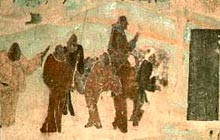 Let us leave the ancient remnants of this Great Wall to travel along the local trade route that led Chinese culture to clash for its first time with a foreign civilization. The Silk Road brought great economic and military benefits to China. The westward export of goods from China fostered terrific fortunes: silks, teas and jade products as well as such brilliant inventions as paper, gunpowder and the compass reaped unimaginable financial rewards. The eastward import of goods most importantly introduced the legendary horses of Central Asia's Ferghana valley; their speed and stamina giving China the military edge in the region. However, the benefits of this trade came at a cost, namely commercial and ideological exchange with alien peoples, societies and cultural values. The homegrown religions of Daoism and Confucianism were threatened by the eastward spread of Buddhism. Han Chinese were forced to deal with the growing military threat of Tibet and the semi-nomadic tribes of the Western regions. Meanwhile the rapid economic and territorial growth of the Chinese Empire was drawing an ever increasing diversity and number of peoples' and thought systems into its sphere of influence. There was a clear danger that this crucible of heterogeneous admixtures would so overheat as to blow the Chinese Empire asunder!
Let us leave the ancient remnants of this Great Wall to travel along the local trade route that led Chinese culture to clash for its first time with a foreign civilization. The Silk Road brought great economic and military benefits to China. The westward export of goods from China fostered terrific fortunes: silks, teas and jade products as well as such brilliant inventions as paper, gunpowder and the compass reaped unimaginable financial rewards. The eastward import of goods most importantly introduced the legendary horses of Central Asia's Ferghana valley; their speed and stamina giving China the military edge in the region. However, the benefits of this trade came at a cost, namely commercial and ideological exchange with alien peoples, societies and cultural values. The homegrown religions of Daoism and Confucianism were threatened by the eastward spread of Buddhism. Han Chinese were forced to deal with the growing military threat of Tibet and the semi-nomadic tribes of the Western regions. Meanwhile the rapid economic and territorial growth of the Chinese Empire was drawing an ever increasing diversity and number of peoples' and thought systems into its sphere of influence. There was a clear danger that this crucible of heterogeneous admixtures would so overheat as to blow the Chinese Empire asunder!
So, how did governors of Dunhuang, the wealthiest and most significant of the borderland areas on the Silk Road, deal with the challenge of managing so much diversity? To understand the factors of their successful strategy, you should firstly put yourself in the saddle of a traveler of the time.
The first time you, yourself, journey to Dunhuang, the closest you will probably come to the vicissitudes of the desert, will be in the flickering shadow of your airplane as it fleets across the pitiless expanses. However, not far from Dunhuang, at the Dunes of the Singing Sands, you can mount a camel and recreate the experience of traveling along the Silk Road two thousand years ago. Even when you are lulled into reverie by your proud-nosed camel's lolling sway, you will still feel the heat of the sun parching your skin. In your imagination, you might see yourself within a large caravan of traders. There may even be a protecting contingent of soldiers accompanying your group. However, it is early morning and the hum of the tall, shifting sands fills you with foreboding. You open your eyes to see the dunes rise out of the air before you; instantly you are dwarfed by the immensity of the desert. One foul sand storm is all that is needed for you to lose your group, your family and your bearings. You recall the stark warning of Fa Xian, that famous monk of the fourth century, who writes from this spot, "the only signs of a road are the skeletons of the dead. Wherever they lie, there lies the road to India." Though you have heard tell of brigands along the way, you now feel all too keenly that your greatest threat lies not from other people, but from nature itself.
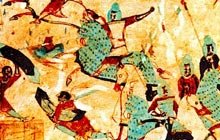 The perennial threat of the desert hung over every oasis town, inhabitant and traveler. This constant reminder of life's transience and death's arbitrariness acted as a break on any dispute; it added a broader dimension to life along the Silk Road. Although this factor naturally calmed social unrest, Dunhuang's governors did not need to rely on it. At any given moment, they could enforce their will through a forceful military presence. The threat of their strong garrison was softened however by conciliatory cultural policies. It is the syncretic give and take of this cultural policy of engagement that is exhibited in the murals of the Mogao Caves.
The perennial threat of the desert hung over every oasis town, inhabitant and traveler. This constant reminder of life's transience and death's arbitrariness acted as a break on any dispute; it added a broader dimension to life along the Silk Road. Although this factor naturally calmed social unrest, Dunhuang's governors did not need to rely on it. At any given moment, they could enforce their will through a forceful military presence. The threat of their strong garrison was softened however by conciliatory cultural policies. It is the syncretic give and take of this cultural policy of engagement that is exhibited in the murals of the Mogao Caves.
In the shadowy caves (take a torch with you), there is no apparent contradiction between the thousands of Buddhas painted on the lower walls and the Daoist symbols painted on the ceiling. Nor is there one between the Confucianist veneration of ancestors on one wall and a representation of the historic Buddha running away from his family on another. Instead of analytically challenging components of each others' belief systems, the artists have assimilated all aspects of the faiths in a rich mythological tapestry. What appears irrational to one person will surely seem inspiring to another – both will agree that the representations are dazzlingly rich and beautiful.
Hegel observed that we learn from history that we do not learn from history. As we enter an age which the historian Samuel Huntingdon has characterized as being afflicted with the clash of competing civilizations, we do well to remember that civilizations have clashed many times before. They did so along the Silk Road approximately two thousand years ago, and the principle fruit of this encounter were hundreds of cave paintings of spell-binding harmony and beauty.
First published March 2003 in Culturaltravels.com under the title "A Study In Harmony".
Day One
At the end of our flight, the oasis town of Dunhuang appears unexpectedly in the midst of a seemingly infinite sandy desert. After landing here in the late afternoon, we will check into the Sun Villa Hotel. Tonight, dinner will be served al fresco in the hotel's spacious gardens (weather permitting). (Silk Road Hotel – Deluxe Suite) (D)
Day Two 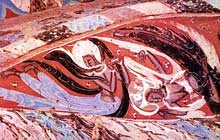
The day starts at one of the world's most impressive cultural heritage sites, the Mogao Caves . Comprising over 400 caves of paintings and sculptures, dating from the fourth to thirteenth centuries, the Mogao Caves are a store of history as much as they are of beauty. Documented amongst the murals are the expeditions of such legendary journeymen as Zhang Qian , the brave expeditioner who first recounted the potential of the Silk Road and Xuan Zhang , the devout monk who imported the first Sanskrit Buddhist texts to China from Northern India. (For most guests, a morning at the Mogao Caves will suffice. Others, however, may wish to spend the whole day exploring the caves.)
After a lunch of local delicacies, we will voyage northwest across the stony desert to Jade Gate Pass (or Yumen Guan), built in the second century BC during the Western Han Dynasty. Named after the high quality jade imported to China from Khotan, 800 miles to the west, the Jade Gate Pass – China's westernmost border crossing – indicated to the weary trader that his eastward journey to China's capital was just under half-complete. A nearby relic from this period is an early remnant of the Great Wall . To enthusiasts, what is most fascinating about this 2,100 year old section is the construction materials used to build it – layers of stamped earth, sand, straw and brushwood. (B, L, D)
Day Three 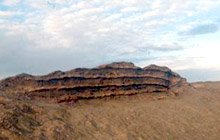
This morning, we will take a camel ride to watch the sun rise over the Mingsha Sand Dunes. There, sitting above the "singing sands," we will breakfast (weather permitting). Before heading to the airport to return to Beijing, there will be time to visit the White Horse Pagoda, built in tribute to the horse of the famous monk- translator Kumarajiva. (B, L)
Please note that B, L, D denotes Breakfast, Lunch, Dinner.
Dunhuang tours are arranged on a private basis only. Visitors interested in a group tour of China, should view our frequent Imperial Tour.
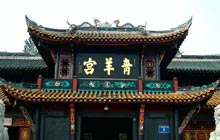 Qingyang Temple , which literally means Temple of the Dark Ram, is the most exquisite and active Daoist temple in Chengdu . The name is associated with many myths, such as Laozi (the mythical founder of Daoism) claiming that he would be reborn in a market where dark rams were sold, to a meeting of Daoist luminaries at which some dark rams were seen. Whatever the truth of the name, it was acquired in the ninth century after some remarkable phenomenon led to the unearthing of a box which contained a seal on which ancient characters with a Daoist message were carved. The temple has halls devoted to a number of luminaries in the Daoist firmament including Lao Zi, one of the trinity of the highest deities in Daoism; but also features halls with the Jade Emperor who ranks as the senior of the Heavenly Emperors, and other lesser deities. If you see religious or spiritual activities taking place that you might think belong elsewhere do not be too surprised. While Daoism does have its own gods and texts it has always been more open to other influences and will absorb ideas we might otherwise associate with Confucianism, Buddhism, or folk religion much more easily than other creeds will.
Qingyang Temple , which literally means Temple of the Dark Ram, is the most exquisite and active Daoist temple in Chengdu . The name is associated with many myths, such as Laozi (the mythical founder of Daoism) claiming that he would be reborn in a market where dark rams were sold, to a meeting of Daoist luminaries at which some dark rams were seen. Whatever the truth of the name, it was acquired in the ninth century after some remarkable phenomenon led to the unearthing of a box which contained a seal on which ancient characters with a Daoist message were carved. The temple has halls devoted to a number of luminaries in the Daoist firmament including Lao Zi, one of the trinity of the highest deities in Daoism; but also features halls with the Jade Emperor who ranks as the senior of the Heavenly Emperors, and other lesser deities. If you see religious or spiritual activities taking place that you might think belong elsewhere do not be too surprised. While Daoism does have its own gods and texts it has always been more open to other influences and will absorb ideas we might otherwise associate with Confucianism, Buddhism, or folk religion much more easily than other creeds will.
The Temple has a public sphere and a more private section where the monks live and practice. The grounds are well-manicured and extensive, and most of the present buildings in the complex date back to the seventeenth century. You can begin your visit with a rub of the ram statue for good luck and then go through to the main halls of worship. To get a good feel for how Daoist philosophy and indigenous Chinese folk religion are all mixed here together don't miss: the signs of the eight trigrams on the Bagua Ting (Pavilion of the Eight Trigrams); the 81 dragons referencing Chinese numerology; and the worshippers in the main hall shaking stalks out of a wooden cone. Once a stalk falls out, the worshipper takes it to a side room where a Daoist Priest exchanges it for an appropriate reading to the silent question the worshipper has asked. If you're feeling lucky then shake a stick yourself or try to throw some coins onto your Chinese zodiac sign.
In addition to the wide-ranging philosophical and folk references within this sanctuary of Chinese thought, there is an impressive array of traditional Daoist activities. Alchemy, once hotly researched here, is related in its exploration of physical and biological laws to the temple's long-standing traditional Chinese medicine practice. The benefits of meditation are combined with precise muscular control in the artful exercise of taiqi as taught by the temple's resident master. The temple's tea ceremony is refined and developed in the same room used by its Daoist orchestra. The combination of richly varied ideologies, images, practices and arts seen in a visit to the Qingyang Temple feels like a celebration of some of the most original and intriguing aspects of traditional Chinese culture.
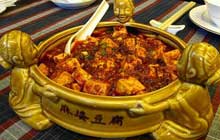 Day One
Day One
Today you will fly to Chengdu, the capital of modern Sichuan province. A historic capital serving as the traditional gateway to the Tibetan plateau, Chengdu has in recent years become a vibrant and sophisticated metropolis. Prepare yourself for mouth-watering Sichuan food, wonderful cultural sites and of course one of the rarest bears on our planet. (Shangri-la Hotel – Executive Riverview Room) (B, L, D)
Day Two
Early this morning we will take you to the Panda Research Institute, set within spacious parkland, where you will be able to observe pandas being fed a breakfast of bamboo shoots in their lush green pens.
Before lunch, we will visit a traditional Chengdu street to view, if not taste, some traditional Sichuanese street foods and tea-houses. This afternoon, you will drive an hour outside the city to visit one of the most mysterious archaeological discoveries of the twentieth century – Sanxingdui. The site is believed to date from the third millennium BCE. As well as cast bronze "sacred trees" on which stand molded singing birds and hundreds of jade and lacquer wares, there are a series of gold-plated bronze masks that are astonishingly beautiful. Compounding the archeological wealth of Sanxingdui is the silence of any historical record positioning this advanced civilization within the arc of China 's pre-history. This has wrapped the site in a shroud of mystery as intriguing and compelling as that of the Egyptian pyramids. (B, L, D)
Day Three
This morning, we will travel to one of China's most important Daoist Temples, Qingyang Temple. Daoism as a religious practice and institution incorporates a broad and set of historic disciplines within its belief system. As well as the worthwhile chemical and herbal research completed over the ages in pursuit of an "Immortality Pill", Qingyanggong also has a Daoist orchestra, a Taiji master, a Taiji tea instructor, a homeophathic doctor and a Daoist restaurant. Quite apart from a personal meeting with a Daoist monk to learn about such ideological matters as synchronicity, the Eight Trigrams and their interaction with the energy forces of Yin & Yang, visitors will be able to investigate some of the above disciplines and also tour the living quarters of the monks. You will be transferred to the airport in time for your flight to your next destination. (B, L)
Please note that B, L, D denotes Breakfast, Lunch Dinner.
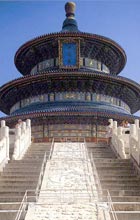
The Temple of Heaven is the most holy of Beijing’s Imperial temples. This is where the Emperor came every winter solstice to worship heaven and to solemnly pray for a good harvest. In ancient China, only the Emperor was allowed to directly worship heaven. Imperial subjects were permitted only to worship their ancestors and river and mountain gods. Therefore, the ceremony conducted at the Temple of Heaven was an act of national importance. Since Imperial rule was legitimized by the”Mandate Of Heaven”, a bad harvest could be interpreted as his fall from heaven’s favor and threaten the stability of his reign. So, it was not without a measure of self-interest that the Emperor fervently prayed heaven to provide a very good crop.
In line with the Confucianist revival during the Ming dynasty, the sacred harvest ceremony was combined with the Emperor’s worship of his ancestors. This embellishment can also be viewed as self-serving. For according to the Confucian pattern of social organization, just as the Emperor respected his ancestors, so a younger brother should respect an elder brother, a wife her husband, a son his father, and a nation’s subjects their ruler. Incorporating ancestor worship within the most solemn ceremony of the Imperial ritual calendar indirectly reinforced the social philosophy that perpetuated the Emperor’s power.
The design of the Temple of Heaven complex, true to its sacred purpose, refers to the mystical cosmological laws believed to be central to the workings of the universe. Hence, complex numerological permutations operate within its design. For example, because the number nine was considered to be the most powerful digit, you will see that the slabs that form the Circular Altar have been lain in multiples of nine. Similarly within the Hall of Prayer for Good Harvest, the interior twenty-eight columns are divided into four central pillars to represent the seasons, twelve inner columns to represent the months and twelve outer columns to represent the two hour tranches that make up a day. There are many such examples of this intense numerology at play.
Whereas in Imperial times commoners were not allowed to enter the enormous park, now for a minimal fee Chinese citizens can enjoy it all day long. Were you to visit at dawn you’d be surprised by the number of people there performing their morning exercises. Next to an older person practicing the slow and flowing movements of Tai Qi, there might be a younger one performing vigorous karate-like punches and kicks. One group might be learning the ancient martial art of sword-fighting, while another might be practising a traditional dance. Should you have the energy and the inclination, it is well worth waking up early one morning and visiting this park to watch such events take place.
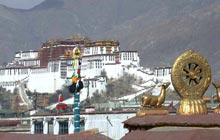 According to ancient mythology the Yarlung valley – not Lhasa – is the homeland of the Tibetan people. The first Tibetan king stepped off a heavenly ladder onto earth not in Lhasa, but here. The Yarlung valley was also the kingly seat of the first Tibetan kings as well as their burial site. This being the case, why is Tibet's capital at Lhasa rather than in the Yarlung valley?
According to ancient mythology the Yarlung valley – not Lhasa – is the homeland of the Tibetan people. The first Tibetan king stepped off a heavenly ladder onto earth not in Lhasa, but here. The Yarlung valley was also the kingly seat of the first Tibetan kings as well as their burial site. This being the case, why is Tibet's capital at Lhasa rather than in the Yarlung valley?
As with many aspects of Tibet's culture, the answer lies in her religious life. For Tibet's original Buddhist temple, dating from the seventh century, was Lhasa's Jokhang Temple , still found today pulsating at the heart of the Old Quarter. This institution, contemporaneous with the first Potala Palace , heralds Buddhism's first insemination and dissemination in a flourishing Tibetan empire stretching from western China to Nepal, Bhutan and northern India. Though its political fortunes would wax and wane, Lhasa – "the place of the Gods" – would forever thus be associated with the birth of Tibetan Buddhism . It is this birthright that would maintain Lhasa's prominence through subsequent centuries of bitter regional and religious conflict.
So it was that in the fifteenth century the ascendant Gelug monastic sect , leading a puritanical Buddhist revival in Tibet, established its three stronghold monasteries, Ganden , Drepung & Sera , in the vicinity of Lhasa. The scholarly achievements and political savvy of this sect eventually pushed Lhasa once more to center stage. Two centuries later, under the leadership of the new paramount leader of Tibet, the Great Fifth Dalai Lama , Lhasa was instituted the religious and political capital of Tibet. In 1645 the Potala Palace was re-constructed on Red Hill and the Jokhang Temple greatly expanded. Although some wooden carvings and door lintels of the Jokhang Temple date to the seventh century, the oldest of Lhasa's extant buildings, such as amidst the Potala Palace, the Jokhang and some of the monasteries and properties in the Old Quarter date to this second flowering in Lhasa's history.
The Potala Palace, uniting the political and religious roles of the Dalai Lama, neatly symbolizes the symbiotic relationship of Lhasa's religious and secular roles. This inter-dependent mapping is also seen in the routes of the city's kora or pilgrimage routes. The innermost pilgrimage route or Nangkhor is a circuit along the inside perimeter of the Jokhang Temple. The Barkhor , the best known, follows the circumference of the Jokhang Temple past other monasteries, temples and incense burners of the Old Quarter. And the last, the Lingkhor , circumambulates the city's former outer limits.
Although the Yarlung valley is indeed the mythological and historical root of the Tibetan nation, the primacy of Buddhism within the fabric of Tibetan culture has ensured that Lhasa supersedes it as the spiritual and political capital of Tibet.
By Guy Rubin
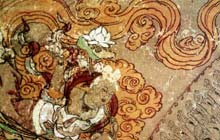 Centuries ago, in a cliff-face in the midst of China's vast Taklamakan desert, artists hollowed, sculpted and painted 492 caves, creating over 450,000 square feet of spectacular murals, or more than thirty times the mural area of the Sistine Chapel. But whereas the Sistine Chapel was painted over a few years, the works at the Mogao Caves began in the fourth century and were completed over the next millennium.
Centuries ago, in a cliff-face in the midst of China's vast Taklamakan desert, artists hollowed, sculpted and painted 492 caves, creating over 450,000 square feet of spectacular murals, or more than thirty times the mural area of the Sistine Chapel. But whereas the Sistine Chapel was painted over a few years, the works at the Mogao Caves began in the fourth century and were completed over the next millennium.
Given that over that thousand year period competing Imperial dynasties, local aristocracies and even foreign nations conquered the nearby city of Dunhuang, it would have been an astounding feat, perhaps even a miracle, for the painted caves to have survived the subsequent wars and mayhem. However, the Mogao caves – in spite of the unavoidable cultural differences between these different religions and peoples – did not just survive, they prospered through this period. For although rival dynasties, families, tribes, religions and nationalities dominated the area, the sheer magnificence of the Mogao Caves was so overwhelming as to prevail over any differences in its successive rulers. Rather than destroy all vestige of their predecessors, a new ruler would instead fund local artists to incorporate his image into the mythological chorus of the caves' hallowed murals. The ruler would thereby use the caves' beauty to legitimize his new administration. In this way, art served as a bridge linking different peoples to each other; the murals provided a space in which alien cultures could make compromises to each other and salve potential sources of enmity. They were used to finesse contradictions between rich and poor, between Confucianists and Buddhists and between Tibetans, Han and other ethnicities. As such, the murals of the Mogao Caves, bespeaking a universal harmony, herald the triumph of transcendent beauty over the destructive dynamic of temporal orders.
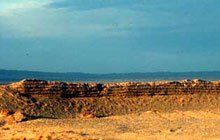 Compare this example of cultural intercourse and compromise with another of Dunhuang's famous sites – the remnants of the earliest sections of the Great Wall. This 16 foot high wall of stamped earth, reinforced with wood, appears as spectacularly random in the midst of the world's second-largest desert. Over two thousand years old, this sinuous fortification, as weathered and cracked as the gargantuan rock formations it purports to divide, now seems more a product of nature than of humanity. Even though the power and scale of the seemingly infinite desert mock the Great Wall's pretensions to mastery, it is an achievement for this human endeavor to have been constructed and have survived for so long in such a hostile environment.
Compare this example of cultural intercourse and compromise with another of Dunhuang's famous sites – the remnants of the earliest sections of the Great Wall. This 16 foot high wall of stamped earth, reinforced with wood, appears as spectacularly random in the midst of the world's second-largest desert. Over two thousand years old, this sinuous fortification, as weathered and cracked as the gargantuan rock formations it purports to divide, now seems more a product of nature than of humanity. Even though the power and scale of the seemingly infinite desert mock the Great Wall's pretensions to mastery, it is an achievement for this human endeavor to have been constructed and have survived for so long in such a hostile environment.
On the one hand, the Mogao Caves create a space for cultures to meet. On the other, the Great Wall was intended to keep cultures apart.
From its inception thousands of years ago, the Great Wall has been a touchstone for debate on how China should deal with her fierce neighbors. Opponents of the Great Wall claimed that peace could only be assured through economic, social and political engagement with China's borderland tribes. When this policy of engagement was preponderant, the borderlands were peaceful. However, at just these times, proponents of the Great Wall argued that Chinese prestige was suffering as a result of China's continual concessions to the warlike tribes, and thus the pendulum swung the other way.
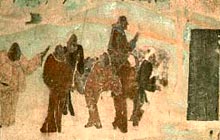 Let us leave the ancient remnants of this Great Wall to travel along the local trade route that led Chinese culture to clash for its first time with a foreign civilization. The Silk Road brought great economic and military benefits to China. The westward export of goods from China fostered terrific fortunes: silks, teas and jade products as well as such brilliant inventions as paper, gunpowder and the compass reaped unimaginable financial rewards. The eastward import of goods most importantly introduced the legendary horses of Central Asia's Ferghana valley; their speed and stamina giving China the military edge in the region. However, the benefits of this trade came at a cost, namely commercial and ideological exchange with alien peoples, societies and cultural values. The homegrown religions of Daoism and Confucianism were threatened by the eastward spread of Buddhism. Han Chinese were forced to deal with the growing military threat of Tibet and the semi-nomadic tribes of the Western regions. Meanwhile the rapid economic and territorial growth of the Chinese Empire was drawing an ever increasing diversity and number of peoples' and thought systems into its sphere of influence. There was a clear danger that this crucible of heterogeneous admixtures would so overheat as to blow the Chinese Empire asunder!
Let us leave the ancient remnants of this Great Wall to travel along the local trade route that led Chinese culture to clash for its first time with a foreign civilization. The Silk Road brought great economic and military benefits to China. The westward export of goods from China fostered terrific fortunes: silks, teas and jade products as well as such brilliant inventions as paper, gunpowder and the compass reaped unimaginable financial rewards. The eastward import of goods most importantly introduced the legendary horses of Central Asia's Ferghana valley; their speed and stamina giving China the military edge in the region. However, the benefits of this trade came at a cost, namely commercial and ideological exchange with alien peoples, societies and cultural values. The homegrown religions of Daoism and Confucianism were threatened by the eastward spread of Buddhism. Han Chinese were forced to deal with the growing military threat of Tibet and the semi-nomadic tribes of the Western regions. Meanwhile the rapid economic and territorial growth of the Chinese Empire was drawing an ever increasing diversity and number of peoples' and thought systems into its sphere of influence. There was a clear danger that this crucible of heterogeneous admixtures would so overheat as to blow the Chinese Empire asunder!
So, how did governors of Dunhuang, the wealthiest and most significant of the borderland areas on the Silk Road, deal with the challenge of managing so much diversity? To understand the factors of their successful strategy, you should firstly put yourself in the saddle of a traveler of the time.
The first time you, yourself, journey to Dunhuang, the closest you will probably come to the vicissitudes of the desert, will be in the flickering shadow of your airplane as it fleets across the pitiless expanses. However, not far from Dunhuang, at the Dunes of the Singing Sands, you can mount a camel and recreate the experience of traveling along the Silk Road two thousand years ago. Even when you are lulled into reverie by your proud-nosed camel's lolling sway, you will still feel the heat of the sun parching your skin. In your imagination, you might see yourself within a large caravan of traders. There may even be a protecting contingent of soldiers accompanying your group. However, it is early morning and the hum of the tall, shifting sands fills you with foreboding. You open your eyes to see the dunes rise out of the air before you; instantly you are dwarfed by the immensity of the desert. One foul sand storm is all that is needed for you to lose your group, your family and your bearings. You recall the stark warning of Fa Xian, that famous monk of the fourth century, who writes from this spot, "the only signs of a road are the skeletons of the dead. Wherever they lie, there lies the road to India." Though you have heard tell of brigands along the way, you now feel all too keenly that your greatest threat lies not from other people, but from nature itself.
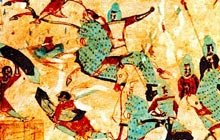 The perennial threat of the desert hung over every oasis town, inhabitant and traveler. This constant reminder of life's transience and death's arbitrariness acted as a break on any dispute; it added a broader dimension to life along the Silk Road. Although this factor naturally calmed social unrest, Dunhuang's governors did not need to rely on it. At any given moment, they could enforce their will through a forceful military presence. The threat of their strong garrison was softened however by conciliatory cultural policies. It is the syncretic give and take of this cultural policy of engagement that is exhibited in the murals of the Mogao Caves.
The perennial threat of the desert hung over every oasis town, inhabitant and traveler. This constant reminder of life's transience and death's arbitrariness acted as a break on any dispute; it added a broader dimension to life along the Silk Road. Although this factor naturally calmed social unrest, Dunhuang's governors did not need to rely on it. At any given moment, they could enforce their will through a forceful military presence. The threat of their strong garrison was softened however by conciliatory cultural policies. It is the syncretic give and take of this cultural policy of engagement that is exhibited in the murals of the Mogao Caves.
In the shadowy caves (take a torch with you), there is no apparent contradiction between the thousands of Buddhas painted on the lower walls and the Daoist symbols painted on the ceiling. Nor is there one between the Confucianist veneration of ancestors on one wall and a representation of the historic Buddha running away from his family on another. Instead of analytically challenging components of each others' belief systems, the artists have assimilated all aspects of the faiths in a rich mythological tapestry. What appears irrational to one person will surely seem inspiring to another – both will agree that the representations are dazzlingly rich and beautiful.
Hegel observed that we learn from history that we do not learn from history. As we enter an age which the historian Samuel Huntingdon has characterized as being afflicted with the clash of competing civilizations, we do well to remember that civilizations have clashed many times before. They did so along the Silk Road approximately two thousand years ago, and the principle fruit of this encounter were hundreds of cave paintings of spell-binding harmony and beauty.
First published March 2003 in Culturaltravels.com under the title "A Study In Harmony".